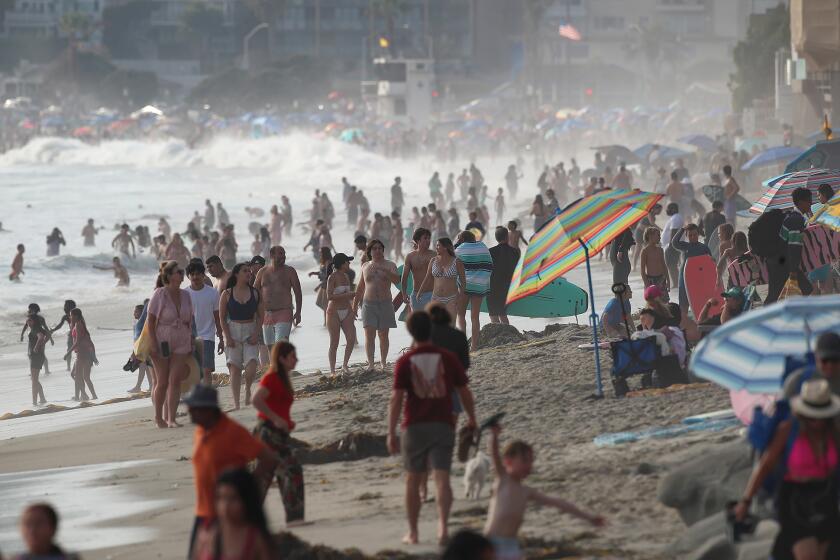Higher-than-expected bids prolong process of putting Newport utility lines underground
- Share via
Placing utilities underground is becoming more expensive in Newport Beach, and as the city and Southern California Edison redesign and re-bid projects to bring down costs, it’s taking longer too.
Earlier this year, the city expected workers to begin the process of burying all electrical and other overhead utility lines on Balboa Boulevard between Coast Highway and the Newport Pier around April.
Now, the best-case scenario is groundbreaking in February, said Assistant City Engineer Mike Sinacori. Most likely, he said, it won’t be until September 2019.
That’s after looking for ways to cut costs by splitting the project and trimming some portions.
Three other Balboa Peninsula projects have overshot estimates by $100,000 to $1.5 million. A project in Corona del Mar had a $2.1-million overrun. All were bid by Edison, not the city, and all are still waiting to launch after being in the pipeline for three to five years.
Newport Beach has had dozens of undergrounding districts over the years.
Newer neighborhoods, such as in Newport Coast, are built with utilities underground and a premium is included in the cost of the homes. For older areas that make the switch, it’s usually funded through assessment districts initiated by residents.
That self-funded option, managed by Edison with some financing and permitting coordination by the city, can cost as much as $10,000 to $25,000 per home, plus $3,500 to $5,000 per home to tap into the grid.
A less common funding method, such as the one planned for Balboa Boulevard, uses money collected from all Edison customers. Those projects are along major roads where the work is considered to benefit the general public.
In the Corona del Mar case, the city took over the bidding process, collecting 13 bids to Edison’s four. Edison initially had estimated a $3.8-million price tag for the project, but its bids came in at $5.9 million. City staff got it to $3.8 million and will take it to the City Council for approval this month. The process, however, added 10 months to the timeline.
The Balboa Boulevard project, meanwhile, was estimated at $4.1 million, then bid at $5.9 million in March. It was then reworked and was reset at $8.6 million in April. Now the city is trying to find ways to cut the cost.
Mark Vukojevic, Newport Beach’s city engineer and deputy public works director, said at Tuesday’s council meeting that the city has a good relationship with Edison but that the company’s confidentiality rules for bid information can be frustrating, like a “blindfold.”
“They are the expert and we have to rely on them as the expert, but when it gets down to [when] we want more information so we can verify costs, so we can look at efficiencies — all the things that we do … when you’re looking at how to deliver something efficiently and cost-effectively … we can’t get to that number.”
He said high overhead appears to be one reason for cost overruns.
Tony Mathis, an Edison project manager, said company policy is to keep bid details confidential, even internally to some extent, to protect the competitive process.
He said Edison, Pacific Gas & Electric Co. and San Diego Gas & Electric have been seeing steeper bids recently, but there must be something different with how they and the city bid out projects that is worth exploring.
About eight to 10 years ago, during the recession, there were a lot of “hungry contractors,” he said.
“There are no hungry contractors [now], at least not the ones that we’re bidding, so we’re not getting very attractive prices when it comes to competitive bidding,” he said.
Mathis said he understands that burying utility lines is important, but Edison considers undergrounding to be aesthetic improvements and a lower priority than improving reliability and strengthening the electrical system.
Newport Beach Mayor Pro Tem Will O’Neill said it’s about more than appearance, citing the downed power lines and falling tree limbs that set off last year’s devastating wine country fires and continuing fire fears in Laguna Beach.
Councilman Jeff Herdman said there also are safety risks from overhead lines on densely populated Balboa Island.
“You can see our dilemma as far as financial stewards of the city about transparency,” Herdman said. “We trust … the experts, but we need to verify costs, and we have a very, very difficult time getting that out of Edison.”
Resident Bill Willis, a retired Edison manager who formerly worked on undergrounding design, said he also doesn’t understand the process and that the city needs to be able to manage the engineering.
“It seems strange that today [the] city’s overhead costs — we all think government overheads are exorbitant — is less than Edison’s,” he said.
Twitter: @Daily_PilotHD
All the latest on Orange County from Orange County.
Get our free TimesOC newsletter.
You may occasionally receive promotional content from the Daily Pilot.




